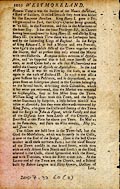






 next page
next page

Romans Time it was the Station of the Mauri Aureliani, a Band of Soldiers, so called because they were sent hither by the Emperor Aurelian. King Henry I. gave it Privileges equal to York that city's Charter being granted, as 'tis said, in the Forenoon, and this in the Afternoon of the same Day. It has the same Privileges still, its Charter having been confirmed by King Henry II. and also by King Henry III. (in whose Time there was an Exchequer here) and by the succeeding Kings of England. In the Reign of King Edward I. it had a Mayor and two Provosts, who sign'd the publick Acts of the Town together with the Mayor, tho' at present they only attend the Mayor with two Halberds. Brompton makes mention of Applebyshire, and 'tis supposed that it had once Sheriffs of its own, as most Cities had; or else that Westmoreland was called the County of Appleby or Applebyshire. In the 22d of Henry II. it was set on Fire by the Scots, as it was again in the 12th of Richard II. In 1598 it was also a great Sufferer by a Pestilence, and so depopulated, as appears from an Inscription placed in the Garden belonging to the School-house, describing those Calamities, which it has never yet recovered, that the Market was removed to Gilshaughlin, four or five Miles from the Town. William King of Scots took this Town, and the Burgh under Stanemore by Suprize, a little before himself was taken at Alnwick; but they were afterward recovered by King John, who gave the Castle and Barony of this Town and the Burgh to John de Vipont, whose Family and that of the Cliffords have been Lords of this County, and flourished at this Place for above 500 Years. Its Market is on Saturdays, and Fairs on Whit monday, May 30, and June 10.
The Assizes are held here in the Town-hall, but the Goal for Malefactors, which was formerly in the Castle, is now at the End of the Bridge. Here is the best Corn-market in all these northern Parts; but the chief Beauty of the Town consists in one broad Street, which runs with an easy Ascent from North and South; at the Head whereof is the Castle, almost surrounded with the River, and with Trenches, where the River comes not. At the Lower-end of the Town are the Church, and a School built by Robert Langton and Miles Spencer, Doctors of
Law,








 Simpson's Agreeable Historian, 1746
Simpson's Agreeable Historian, 1746